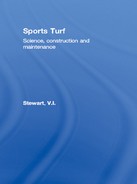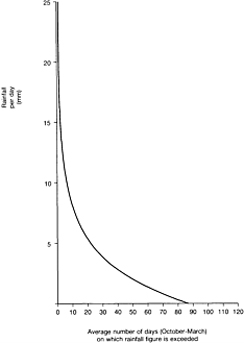Chapter five
This chapter was contributed by J.C.Parker, B.Sc. Hort., A.L.I., Chief Landscape Manager, Kent County Council, based on a section originally included in Landscape Management and Maintenance—A Guide to its Costing and Organisation, published by Gower Technical, 1989.
Cost benefit implications
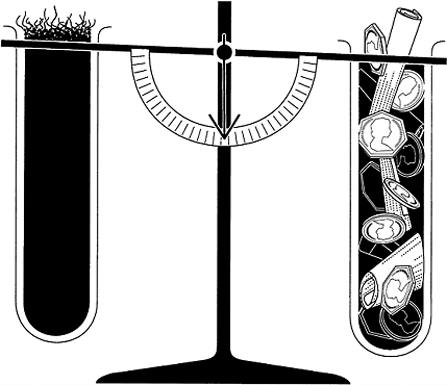
5.1
Assessing the value of drainage
The economic value of drainage on any plot of land is usually difficult to quantify in precise terms. Even in agriculture where crop yields can be accurately measured, it is still not possible to predict with any certainty what would be the most economic level of artificial drainage in terms of return on the capital involved. This does not mean that the advantages of drainage are not discernible but it does mean that it is very difficult to estimate the optimum level of capital investment.
In sports-field drainage the advantages are even more difficult to assess in economic terms. At best the capital costs can only be compared with matches played or not played, or the number of days on which the surface is fit for use. Nevertheless, the costs of drainage can be considerable and it is important to at least try to predict what advantages could accrue from the installation of various alternative systems. This is particularly so when the performance of a drainage system can be accurately designed, as shown elsewhere in this book.
The advantages of playing-field drainage are mainly that surface water (rainfall) is cleared more rapidly and that the soil provides a better playing surface and a better growing medium for the turf. The latter advantage is often the most important in agriculture and promotes:
- earlier warming of the soil in spring because any substitution of air for water means lower specific heat;
- earlier spring regeneration of worn turf because of the beneficial effect on soil temperature;
- improved drought resistance because of deeper, more efficient rooting.
These improvements during the growing season can be considerable but during the winter months the more important effect of drainage is that rainfall is removed faster from the surface so that play can take place on a reasonably firm surface and without unduly damaging the soil structure. This increased availability for play is the factor on which most players would base their judgement on the value or otherwise of a drainage system.
5.2
How much drainage is needed?
The optimum drainage rate that a designer should try to achieve depends on:
- the rainfall that can be expected;
- the proportion of lost playing days that the client is prepared to accept;
- the anticipated pattern of use.
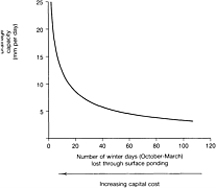
FIGURE 5.1 Average winter rainfall distribution
Looking first at rainfall, Figure 5.1 shows, as an example, how rainfall is likely to be distributed throughout the winter months. The graph is based on a ten-year period at a recording station in the south-east of England. It shows that for half the days there was very little or no rain at all and only on about 20 days (11%) in the whole winter was there more than 5 mm of rain. (Graphs from wetter parts of the country would show higher rainfalls but are likely to show a similar distribution pattern.)
This rainfall evidence suggests that even a modest drainage rate would probably make a pitch playable for the majority of the time. However, with a low drainage rate it is likely that the heavy rain, from the few really wet
days, would flood the surface for several days afterwards. Taking this last factor into account Figure 5.2 has been constructed to show the likely number of lost days that can be expected with various levels of drainage capacity.
This again shows that for most of the time a relatively low drainage rate would be likely to keep the pitch clear and high drainage rates may only be needed for a very small number of days in any one year. Therefore, if the users can afford to be flexible in the way they use the pitches in winter, and only use them when weather conditions are favourable, a relatively low drainage rate would be adequate. If, however, there is strong user pressure to play on pitches whatever the weather, the drainage rate needs to be very much higher so that it will deal with most intensities of rain as it falls. A professional football club ground, for instance, probably comes within the second category. Here, the necessary capital expenditure and maintenance of a high-intensity drainage system can usually be justified by fewer matches having to be cancelled.
Figures 5.1 and 5.2 both refer to theoretical drainage requirements but in practice much higher rates are likely to be needed to take account of:
- local ponding in dips and hollows;
- gradual deterioration of the drainage system (silting up etc.);
- higher rainfall in wetter parts of the country;
- year-to-year variations (when rainfall is above average).
Therefore, as a general guide, a drainage rate of at least 25 mm (1 in) per day is probably needed for even a lightly used winter pitch and, at the other end of the scale, a professional football pitch might require as much as 25 mm (1 in) per hour to be reasonably confident of staging matches, whatever the weather. However, such a very high drainage rate could only be achieved by a sand soil perched over a drained, gravel bed and such a soil needs special maintenance and shielding from too frequent use.
5.3
Effect of drainage system design on capital cost
When sports-field drainage systems are being designed there are often several different ways of achieving the same or similar results but the costs of the alternatives can sometimes be very different. In each situation the designer has to work out the likely cost difference and, for instance, decide between either a system of substantial surface slits and few underdrains or simple slits with many closely spaced interceptors.
The final solution will depend on many factors, including the local availability of suitable materials, machinery and contractors, but the general principles given below should help as a guide towards achieving the lowest capital cost.
5.4
Spacing of underground laterals or interceptor drains
Underground laterals, with or without pipes, are nearly always more expensive to construct per metre than surface slits. For this reason alone it would appear more sensible to use as few as possible. However, extra capital spent on underground laterals is usually more than amply repaid in drainage capacity and, as a general rule, a doubling of the number of underdrains will give the potential for a four-fold increase in drainage rate.
Example 5.1
If laterals are laid 10 m (11 yards) apart in a uniformly draining soil, 500 mm (20 in) deep with hydraulic conductivity of 10 mm/h (4/10 in/h), then, using equation (4.4) on page 67
![]()
the drainage rate V will be
![]()
If, however, the laterals are laid at 5-m (5 1/2-yard) centres the drainage rate will be
This example shows the advantages of extra underground laterals and illustrates that a misguided attempt to save capital costs by halving the number of laterals would reduce the drainage to a quarter of the original design rate.
This same principle will apply to the lower levels of any two- or three-tier system of underground drains connecting with surface sand slits. However, it does not apply to the top layer of slits that collect rain water directly from the surface.
TABLE 5.1 Costed schemes—examples of slit drainage systems with a design rate of 48 mm/day (2 mm/hr)
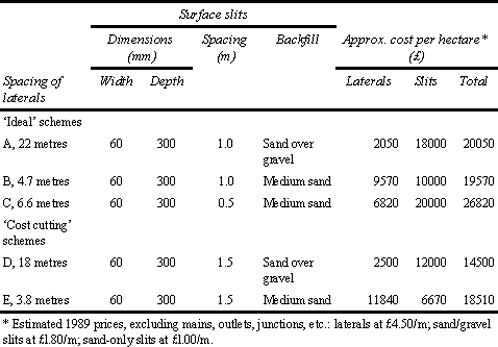
5.5
Spacing of surface slits
Surface slits are usually relatively cheap per metre run but, because they are close together and many metres have to be laid, their total cost is a major part of the capital outlay. It is therefore often tempting to space them as widely apart as possible.
The scope for such saving is severely limited as surface slits only have an effective influence over a very narrow band, simply because rain water can travel only very slowly across the grassed surface. Footmarks and the like will slow down the surface flow even on a surface that has a gentle slope. In practice, therefore, a surface slit will drain a band only about 1.50 m (5 ft) wide. Thus, even if slits are placed at 2 m (61/2 ft) apart there is a considerable risk of surface ponding or sogginess between the runs.
For this purely technical reason it is usually best to space surface slits about 1 m (1 yard) apart. Closer spacing will improve the efficiency of surface interception still further but the costs will increase pro rata.
Savings on surface slits can sometimes be made by only slitting the heavily used or badly drained parts of a pitch or field. Alternatively a whole pitch can be slit at 1.5-m (5-ft) centres with additional slits put between to give 0.75 m (2 1/2 ft) spacing of the wet or heavily used areas. (Note that this only gives a cost saving, compared with 1 m spacing overall, if wet areas are less than half the total area.)
5.6
Cost comparisons of alternative systems
Some examples of possible costs of alternative systems are shown in Table 5.1. The figures (based on 1989 prices) have been deliberately simplified in order to illustrate the comparisons and must only be used in that context. The availability of different materials and machinery could well alter the conclusions and in each case the designer must work out the costs that are likely to apply to the specific site. Some comments on the data in Table 5.1 now follow.
- There is little to choose between schemes A and B but B has the advantage that even underground laterals would give a fair measure of drainage if the permeable fill in the pipe trenches was brought through to the surface as sand, especially if the field was lightly used and retained a good surface structure. Scheme A might be preferred if ground conditions were difficult for deep trenching.
- Scheme C has the same advantages as but the extra cost of the close-spaced slits is unlikely to be justified except on very heavily used areas—goalmouths, etc.
- Scheme D is significantly cheaper than all the other options considered, but wider slit spacing would be less effective under heavy use, particularly where the ground is level.
- Scheme E has only a slight cost advantage over A, B or C and would normally not be worth considering.
- Schemes A and D could be upgraded to a design rate of 8 mm per hour by doubling the number of underground laterals at an extra capital cost of only around £4.50 per metre.
5.7
Effect of drainage on total use
All the above have been concerned with the effect of drainage rates on the chances of pitches being waterlogged at any one time and do not take account of the total hours of use once drainage problems have been eliminated. This total use is normally limited by the amount of wear that the actual surface carpet of turf is able to bear. Improved drainage will influence this to the extent that it encourages better growth and also that a drier surface discourages the players from sliding and damaging the turf by a shearing action. However, the more important effect of adequate drainage is to make a pitch playable throughout the season and allow considerably more play in the wettest months of the winter. Without drainage the pitch could be completely unplayable for weeks on end.
5.8
Cost-saving strategy for a new playing field
Artificial drainage is only necessary when the natural drainage is inadequate. When a new playing field is being planned it is extremely difficult to assess, in advance, what the natural drainage rate will be. Soil structure can easily be destroyed by adverse weather conditions during levelling and grading, or merely by the time the topsoil stays in a stockpile.
Once a field is sown down to grass the natural soil structure may regenerate again within a year or two on heavy clays by the natural expansion and contraction of the clay particles through the seasons. On silty soils however, the natural structure will always be weak and, once lost, may not reform for very many years. Therefore, depending on soil type an elaborate and expensive drainage system could be of only temporary value or an absolute necessity, essential in the long term.
In order to minimize the risks of either extreme it would be wise to install only a basic underdrainage system during the construction stage. Subsequently a slit drainage system could be added if it is found to be necessary. This could be laid out across the whole field or just across goalmouths and any especially wet areas. Alternatively in scheme A, Table 5.1, the major capital cost could at least be delayed until experience proves that a full slit system is needed.
In these and other ways capital costs can be kept to a minimum, but there are often administrative difficulties with obtaining an additional capital sum for sand slitting several years after the main part of the construction has been completed. It is therefore essential to ensure that the promoters of the construction scheme are aware of the possible need for extra works as the new playing field becomes established.
Finally, it cannot be over-emphasized that any drainage system will be largely wasted if it is not backed up by regular maintenance, not only to prevent pipe blockage and smearing of sand slits, but also to retain as open a soil structure as possible.
